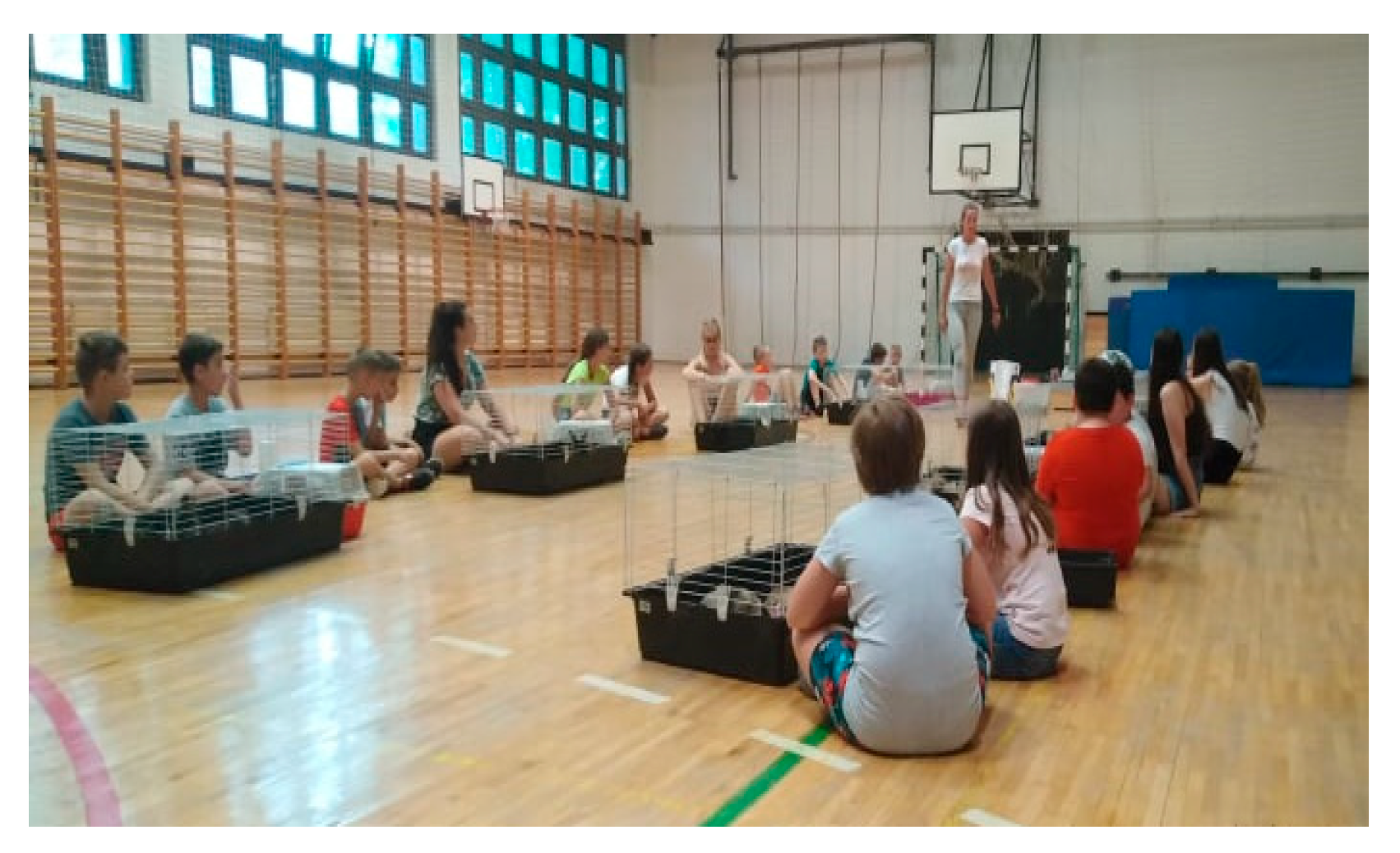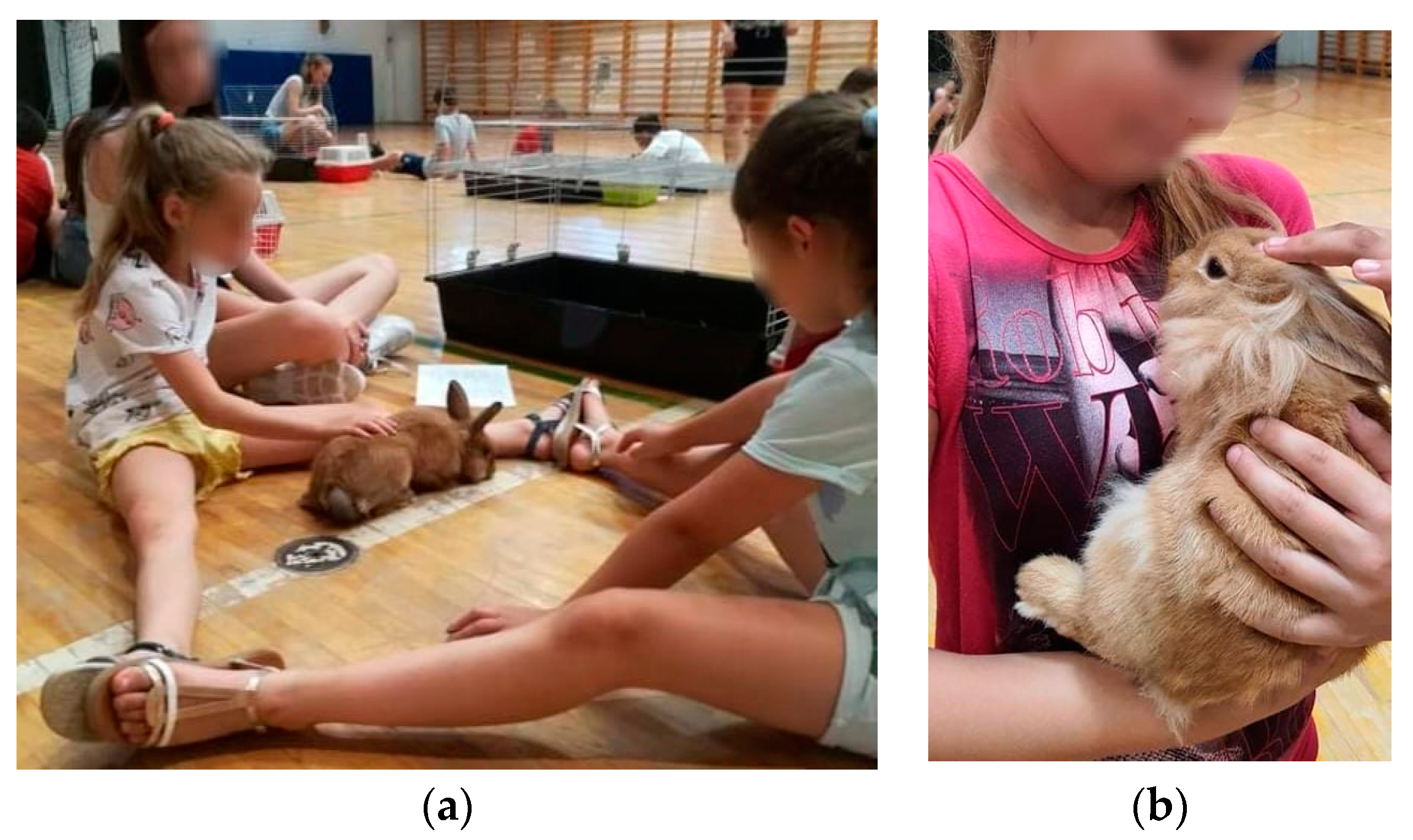Changes in the Stress Tolerance of Dwarf Rabbits in Animal-Assisted Interventions
Abstract
:1. Introduction
1.1. Stress Induced by Animal-Assisted Interventions
- -
- The rabbits’ welfare is the priority;
- -
- It is expected that the animals feel comfortable during the sessions, which should never be forced;
- -
- Before, during and after the interventions, we need to give time for them for acclimatization or recovery;
- -
- Trainers/owners of the rabbits must protect them from human-animal zoonotic diseases and illnesses [21].
1.2. Preparing the Rabbits to AAI Work
1.3. Studies Made with Rabbits: Previous Research Results
2. Materials and Methods
2.1. Housing and Feeding
2.2. Human Approach Tests
- -
- First, confidentiality was tested with the owner (S-B.É., a PhD student, animal husbandry engineer, pet and hobby animal breeder with a training specialization) with a test consisting of 12 tasks. (Owner Approach Test, “OAT”, subject of Appendix A).
- -
- Then, the animals’ behavior and stress tolerance were tested by involving 120 children. Based on the school-teaching model, we had three 45 min long sessions in a row with 15 min long breaks between them. As part of the sessions, the children completed a simplified human approach test with the rabbits (Children Approach Test, “CAT”, subject of Appendix B), the main parts of which focused on the rabbits’ interest, indifference and fear. This gave us the opportunity to gain information on how the rabbit individuals reacted to repeated stress. The sessions thus yielded three test results on the relationship between children and rabbits.
- -
- Finally, after transporting the rabbits back to their housing area, we repeated the 12-item Owner Approach Test on the rabbits with the owner. Thus, we obtained results on the extent to which the animal-assisted session affected the rabbits’ confidentiality with their owners and indirectly on the level of stress.
- -
- There is a significant difference between the rabbits’ stress toleration levels according to the handling they received during the sensitive period after birth.
- -
- In a three-times repeated animal-assisted intervention, the rabbits are able to cooperate without significant decreases in their stress toleration if the interventions do not take longer than 20 min and we give at least 30 min retreat for them.
2.3. The Owner Approach Test (OAT)
2.4. The Children Approach Test (CAT)
2.5. Statistical Analysis
3. Results
3.1. The Rabbits’ Behavior According to the Owner Approach Test
3.2. Rabbits’ Behavior According to the Children Approach Test
4. Discussion
5. Conclusions
Author Contributions
Funding
Institutional Review Board Statement
Informed Consent Statement
Data Availability Statement
Acknowledgments
Conflicts of Interest
Appendix A
Appendix B
References
- Brooks, H.L.; Rushton, K.; Lovell, K.; Bee, P.; Walker, L.; Grant, L.; Rogers, A. The power of support from companion animals for people living with mental health problems: A systematic review and narrative synthesis of the evidence. BMC Psychiatry 2018, 18, 1–12. [Google Scholar] [CrossRef] [PubMed] [Green Version]
- Warga, É. Stresszkönyv Avagy: Hogyan Legyünk Egészségesek És Energikusak a Stressz Ellenére Is; LPI Publisher: Budapest, Hungary, 2009; pp. 5–10, 42–43. ISBN 978-963-9813-0803. [Google Scholar]
- Bánszky, N.; Kardos, E.; Rózsa, L.; Gerevich, J. Az állatok által asszisztált terápiák pszichiátriai vonatkozásai. Psychiatr. Hunga. 2012, 27, 180–190. [Google Scholar]
- Becker, M.; Danelle, M. Az Állatok Gyógyító Ereje; Gold Book Kft: Debrecen, Hungary, 2002; pp. 56–57. ISBN 978-963-426-073-8. [Google Scholar]
- Sipos, K.; Bodnar, K.; Paraszt, M.; Sontra, B. The effect of pet rabbits on the personality development of high school students. Lucrǎri Ştiinţ. 2019, 21, 102–107. [Google Scholar]
- Molnár, M.; Rudolf, Z.; Szalai, K.; Takács, I. Pedagógusképzést segítő hálózatok továbbfejlesztése a Dél-Dunántúl régióban. In Állatasszisztált pedagógai és terápia, TÁMOP-4.1.2.B.2-13/1-2013-0014; LPI Publisher: Budapest, Hungary, 2015. [Google Scholar]
- Urichuk, L.J.; Anderson, D. Current use of animal-assisted therapy. In Improving Mental Health through Animal Assisted Therapy; Chimo Project: Edmonton, AB, Canada, 2003; ISBN 0-9732944-0-X. [Google Scholar]
- Loukaki, K.; Koukoutsakis, P.; Kostomitsopoulos, N. Animal welfare issues on the use of rabbits in an animal assisted therapy program for children. J. Hell. Vet. Med. Soc. 2010, 61, 220–225. [Google Scholar] [CrossRef] [Green Version]
- Mallon, G.P. Utilization of animals as therapeutic adjuncts with children and youth: A review of the literature. Child Youth Care Forum 1992, 21, 53–67. [Google Scholar] [CrossRef]
- Demello, M. Rabbits multiplying like rabbits: The rise in the worldwide popularity of rabbits as pets. Companion Anim. Everyday Life 2016, 91–107. [Google Scholar] [CrossRef]
- Molnár, M.; Iváncsik, R.; Di Blasio, B.; Nagy, I. Examining the effects of rabbit-assisted interventions in the classroom environment. Animals 2020, 10, 26. [Google Scholar] [CrossRef] [PubMed] [Green Version]
- Smith, M.H.; Meehan, C.L.; Ma, J.M.; Hisakawa, N.; Dasher, H.S.; Camarillo, J.D.; Techanun, J. Rabbits—From the Animal’s Point of View, 1: What Does It Mean to Be a Rabbit? University of California Agriculture & Natural Resources 4-H, Youth and Family: Davis, CA, USA, 2009. [Google Scholar] [CrossRef]
- Our ethical and moral responsibility: Ensuring the welfare of therapy animals foundations and guidelines for animal-assisted interventions. In Handbook on Animal-Assisted Therapy, 4th ed.; Fine, A.H. (Ed.) Academic Press: Cambridge, MA, USA, 2015; pp. 357–376. ISBN 9780128014363. [Google Scholar]
- Broom, D.M.; Fraser, A.F. Domestic Animal Behaviour and Welfare, 5th ed.; CABI Wallingford: Wallingford, UK, 2015; p. 462. ISBN1 1780645392. ISBN2 9781780645391. [Google Scholar]
- Preziosi, R.J. For your consideration: A pet-assisted therapy facilitator code of ethics. Latham Lett. 1997, 18, 5–8. [Google Scholar]
- Forkman, B.; Boissy, A.; Meunier-Salaün, M.-C.; Canali, E.; Jones, R.B. A critical review of fear tests used on cattle, pigs, sheep, poultry and horses. Physiol. Behav. 2007, 92, 340–374. [Google Scholar] [CrossRef] [PubMed] [Green Version]
- Mayer, J. Use of behavior analysis to recognize pain in small mammals. Lab. Anim. 2007, 36, 43–48. [Google Scholar] [CrossRef] [PubMed]
- Mullan, S.; Main, D.C.J. Survey of the husbandry, health and welfare of 102 pet rabbits. Veter.-Rec. 2006, 159, 103–109. [Google Scholar] [CrossRef] [PubMed]
- Crowell-Davis, S.L. Behavior Problems in Pet Rabbits. J. Exot. Pet Med. 2007, 16, 38–44. [Google Scholar] [CrossRef]
- Verga, M.; Castrovilli, C.; Ferrante, V.; Grilli, G.; Heinzl, E.; Luzi, F.; Toschi, I. Effetti della manipolazione e dell’arricchimento ambientale su indicatori integrati di “benessere” nel coniglio. Coniglicoltura; Riv. Coniglicoltura Italy 2004, 41, 26–35. [Google Scholar]
- Serpell, J.A.; Coppinger, R.; Fine, A.H.; Peralta, J.M. Welfare considerations in therapy and assistance animals, Theoretical Foundations and Guidelines for Practice. In Handbook on Animal-Assisted Therapy, 3rd ed.; Academic Press: Cambridge, MA, USA, 2010; pp. 481–503. [Google Scholar] [CrossRef]
- Schepers, F.; Koene, P.; Beerda, B. Welfare assessment in pet rabbits, Animal Welfare. Univ. Fed. Anim. Welf. 2009, 18, 477–485. [Google Scholar]
- D’Ovidio, D.; Pierantoni, L.; Noviello, E.; Pirrone, F. Sex differences in human-directed social behavior in pet rabbits. J. Veter.-Behav. 2016, 15, 37–42. [Google Scholar] [CrossRef]
- Mayer, J.; Donnelly, T.M. Behavioral disorders. In Clinical Veterinary Advisor, Birds and Exotic Pets, 1st ed.; Mayer, J., Donnelly, T.M., Eds.; Elsevier Saunders: St. Louis, MO, USA, 2013; pp. 337–338. [Google Scholar]
- Csatádi, K. A Korai Kezelés És a Korai Táplálkozási Tapasztalatok Hatása a Nyúl (Oryctolagus Cuniculus) Viselkedésének Egyedfejlődésére. Ph.D. Thesis, Hungary Eötvös Lóránd Tudomány Egyetem, Budapest, Hungary, 2007. [Google Scholar]
- Bilkó, Á.; Altbäcker, V. Regular handling early in the nursing period eliminates fear responses toward human beings in wild and domestic rabbits. Dev. Psychobiol. 2006, 36, 78–87. [Google Scholar] [CrossRef]
- Hudson, R.; Schaal, B.; Bilkó, Á.; Altbäcker, V. Just three munutes a day: The behaviour of young rabbits viewed in the context of limited maternal care. In Proceedings of the 6th World Rabbit Congress, Toulouse, France, 9–12 July 1996; Volume 2. [Google Scholar]
- Pongrácz, P.; Altbäcker, V. The effect of early handling is dependent upon the state of the rabbit (Oryctolagus cuniculus) pups around nursing. Dev. Psychobiol. 1999, 35, 241–251. [Google Scholar] [CrossRef]
- Zucca, D.; Redaelli, V.; Marelli, S.P.; Bonazza, V.; Heinzl, E.; Verga, M.; Luzi, F. Effect of handling in pre-weaning rabbits. World Rabbit Sci. 2012, 20, 97–101. [Google Scholar] [CrossRef] [Green Version]
- Molnár, M.; Iváncsik, R.; Di Blasio, B. On the positive effect of rabbit-assisted interventions in classroom environment on the anxiety of pupils. In Education Applications & Developments IV: Advances in Education and Educational Trends; Carmo, M., Ed.; InScience Press: Beijing, China, 2019; pp. 215–225. [Google Scholar]
- Palme, R. Monitoring stress hormone metabolites as a useful, non-invasive tool for welfare assessment in farm animals. Anim. Welf. 2012, 21, 331–337. [Google Scholar] [CrossRef]




| Seconds | Bonus |
|---|---|
| 0–3 | 1 |
| 4–6 | 0.8 |
| 7–9 | 0.6 |
| 10–12 | 0.4 |
| 13–15 | 0.2 |
| Rabbit Number | Total Score | Difference | |
|---|---|---|---|
| Before AAI | After AAI | ||
| 1(H) | 54.6 | 52 | −2.6 |
| 2(H) | 55 | 54.8 | −0.2 |
| 3(H) | 56.8 | 55.4 | −1.4 |
| 4(H) | 52.8 | 52.8 | 0 |
| 5(NH) | 52.6 | 47.8 | −4.8 |
| 6(NH) | 52.8 | 47.2 | −5.6 |
| 7(NH) | 51.6 | 48.8 | −2.8 |
| 8(NH) | 48.4 | 49 | 0.6 |
| 9(NH) | 42.2 | 38.6 | −3.6 |
| 10(NH) | 38.8 | 34.2 | −4.6 |
| 11(NH) | 46.2 | 47.2 | 1 |
| 12(NH) | 39.4 | 37 | −2.4 |
| 13(NH) | 45 | 42.4 | −2.6 |
| 14(NH) | 47.2 | 41 | −6.2 |
| 15(NH) | 45 | 40.4 | −4.6 |
| 16(NH) | 41 | 28.8 | −12.2 |
| 17(NH) | 35.6 | 34.2 | −1.4 |
| 18(NH) | 39.8 | 26.2 | −13.6 |
| 19(NH) | 41.4 | 34.6 | −6.8 |
| 20(NH) | 47.2 | 37.8 | −9.4 |
| Rabbit Number | Total Score | Differences between 1st and 3rd AAI | ||
|---|---|---|---|---|
| 1st AAI | 2nd AAI | 3rd AAI | ||
| 1(H) | 29 | 27 | 20 | −9 |
| 2(H) | 27 | 26 | 25 | −2 |
| 3(H) | 28 | 26 | 23 | −5 |
| 4(H) | 25 | 22 | 16 | −9 |
| 5(NH) | 23 | 21 | 22 | −1 |
| 6(NH) | 22 | 20 | 19 | −3 |
| 7(NH) | 27 | 25 | 21 | −6 |
| 8(NH) | 22 | 20 | 18 | −4 |
| 9(NH) | 20 | 9 | 16 | −4 |
| 10(NH) | 22 | 25 | 29 | 7 |
| 11(NH) | 25 | 23 | 20 | −5 |
| 12(NH) | 20 | 17 | 23 | 3 |
| 13(NH) | 25 | 25 | 20 | −5 |
| 14(NH) | 20 | 23 | 25 | 5 |
| 15(NH) | 23 | 18 | 19 | −4 |
| 16(NH) | 23 | 20 | 14 | −9 |
| 17(NH) | 23 | 23 | 20 | −3 |
| 18(NH) | 19 | 19 | 19 | 0 |
| 19(NH) | 26 | 22 | 22 | −4 |
| 20(NH) | 17 | 26 | 15 | −2 |
Publisher’s Note: MDPI stays neutral with regard to jurisdictional claims in published maps and institutional affiliations. |
© 2022 by the authors. Licensee MDPI, Basel, Switzerland. This article is an open access article distributed under the terms and conditions of the Creative Commons Attribution (CC BY) license (https://creativecommons.org/licenses/by/4.0/).
Share and Cite
Suba-Bokodi, É.; Nagy, I.; Molnár, M. Changes in the Stress Tolerance of Dwarf Rabbits in Animal-Assisted Interventions. Appl. Sci. 2022, 12, 6979. https://doi.org/10.3390/app12146979
Suba-Bokodi É, Nagy I, Molnár M. Changes in the Stress Tolerance of Dwarf Rabbits in Animal-Assisted Interventions. Applied Sciences. 2022; 12(14):6979. https://doi.org/10.3390/app12146979
Chicago/Turabian StyleSuba-Bokodi, Éva, István Nagy, and Marcell Molnár. 2022. "Changes in the Stress Tolerance of Dwarf Rabbits in Animal-Assisted Interventions" Applied Sciences 12, no. 14: 6979. https://doi.org/10.3390/app12146979






